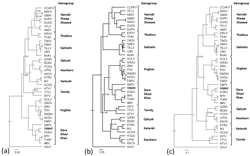|
The discovery of Bombali virus adds further support for bats as hosts of ebolaviruses Here we describe the complete genome of a new ebolavirus, Bombali virus (BOMV) detected in free-tailed bats in Sierra Leone (little free-tailed (Chaerephon pumilus) and Angolan free-tailed (Mops condylurus)). The bats were found roosting inside houses, indicating the potential for human transmission. We show that the viral glycoprotein can mediate entry into human cells. However, further studies are required to investigate whether exposure has actually occurred or if BOMV is pathogenic in humans. |
|
Crimean-Congo haemorrhagic fever (CCHF) virus Crimean-Congo haemorrhagic fever (CCHF) is a widespread disease caused by a tick-borne virus (Nairovirus) of the Bunyaviridae family. The CCHF virus causes severe viral haemorrhagic fever outbreaks, with a case fatality rate of 10–40%.
|
|
First human to human transmission of H7N9
|
|
Neisseria meningitidis
|
|
Characterization of a filovirus (Mengla virus) from Rousettus bats in China Abstract |
|
Genomic Characterisation of Vinegar Hill Virus, An Australian Nairovirus Isolated in 1983 from Argas Robertsi Ticks Collected from Cattle Egrets This report describes the near complete genomic sequence and subsequent analysis of Vinegar Hill virus (VINHV; tentative member of the genus Orthonairovirus, family Nairoviridae, order Bunyavirales). VINHV is the second nairovirus reported to be isolated on mainland Australia and the first to be sequenced and analysed. Our genetic analysis shows that VINHV belongs to the Dera Ghazi Khan genogroup, a group of viruses previously isolated in other parts of the world including Asia, South Africa, and the USA. We discuss possible routes of entry for nairoviruses into Australia and the need to understand the virome of Australian ticks in the context of new and emerging disease. |
|
p45-49 |

